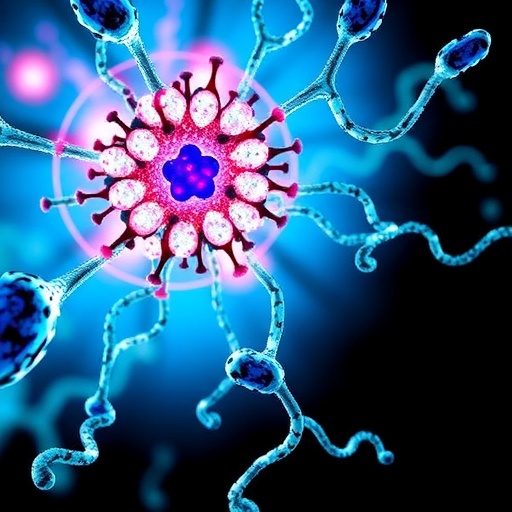
In recent years, the discovery of migrasomes has revolutionized our understanding of cellular communication and homeostasis. Migrasomes are large extracellular vesicles formed on retraction fibers left behind by migrating cells. Their biogenesis is tightly linked to the dynamic processes of cell migration, involving intricate molecular machinery that orchestrates their formation and release. Over the past decade, research has elucidated the roles of migrasomes in physiological contexts, particularly emphasizing their emerging significance in disease mechanisms, ranging from cancer to infectious illnesses.
One of the most exciting developments in migrasome research is their newfound role in maintaining cellular homeostasis under stress conditions. Cells undergoing mild mitochondrial damage can selectively expel dysfunctional mitochondria through migrasomes, a process termed mitocytosis. This clearance pathway provides an alternative to classic mitophagy, especially in highly migratory cells such as neutrophils that require sustained cellular vitality during prolonged circulation. By offloading damaged mitochondria, migrasomes help prevent the intracellular accumulation of toxic mitochondrial fragments that could otherwise impair cell function or trigger detrimental signaling cascades.
Exploring deeper into pathological implications, mounting evidence suggests that aberrations in migrasome formation or regulatory genes correlate with various human diseases. Genomic and transcriptomic profiling across cancer patient cohorts has revealed that migrasome-related genes (MRGs) display altered expression patterns linked to tumor progression, immune evasion, and patient prognosis. Indeed, computational approaches have integrated migrasome signatures into prognostic models, uncovering associations between high migrasome activity and poor clinical outcomes. Such findings suggest that migrasomes may modulate tumor-immune interactions, potentially influencing the tumor microenvironment via macrophage polarization and immune checkpoint pathways.
.adsslot_NDH1SXFex9{width:728px !important;height:90px !important;}
@media(max-width:1199px){ .adsslot_NDH1SXFex9{width:468px !important;height:60px !important;}
}
@media(max-width:767px){ .adsslot_NDH1SXFex9{width:320px !important;height:50px !important;}
}
ADVERTISEMENT
Beyond oncology, migrasome signatures have surfaced in cardiovascular research as critical determinants of acute myocardial infarction (AMI) risk. Machine learning algorithms applied to patient datasets highlighted ITGB1, a key migrasome regulatory gene, as a driver of macrophage behavior in ischemic tissues. This discovered link not only provides prospective biomarkers for early AMI detection but also informs therapeutic strategies, including the possibility that compounds such as ginsenoside Rh1 might modulate migrasome activity to attenuate inflammatory damage during cardiac events.
Physiologically, migrasomes have been found to function as versatile vehicles mediating intercellular communication, delivering functional cargoes such as signaling molecules, proteins, and even nucleic acids. In immune regulation, monocyte-derived migrasomes enriched with pro-inflammatory cytokines have been identified, contributing to the orchestration of inflammation. Experimental models subjected to lipopolysaccharide (LPS) challenge demonstrated elevated neutrophil- and monocyte-derived migrasomes, implicating their involvement in the progression of inflammation-related diseases characterized by aberrant coagulation and cytokine storms.
Recent advances also shed light on the utility of migrasomes as sensitive biomarkers in renal pathology. Podocytes, the specialized glomerular cells, release migrasomes upon injury, and heightened migrasome presence in urine has emerged as a promising non-invasive indicator of early kidney damage. Novel isolation techniques combining wheat germ agglutinin-coated magnetic beads with flow cytometry facilitate the capture and quantification of migrasomes, enhancing diagnostic capabilities and opening avenues for monitoring renal disease progression with high specificity.
Crucially, beyond correlational evidence, direct mechanistic studies have demonstrated that migrasomes actively contribute to disease progression. In the context of bone metastasis, tumor cells induce migrasome formation which in turn promotes the differentiation of osteoclast precursors into mature osteoclasts. This phenomenon, termed tumor-induced osteoclast coupling, is mediated through the transfer of tumor cytoplasmic material via migrasomes, fueling pathological bone resorption. Therapeutic interventions that disrupt migrasome biogenesis, such as nanoliposome-based inhibitors, have shown promise in decoupling these deleterious interactions and mitigating metastasis development.
Neurological disorders also appear to be influenced by migrasome biology. In cerebral amyloid angiopathy models, amyloid beta peptide (Aβ40) induces migrasome production in macrophages, which then deposit CD5L-enriched migrasomes onto blood vessels. This process has been implicated in compromising the blood-brain barrier integrity, with complement activation identified as a contributing factor. Such insights suggest migrasomes may serve as novel players in neurovascular-pathological feedback loops, potentially offering targets for therapeutic modulation in neurodegenerative conditions.
Furthermore, genetic models have affirmed migrasomes’ role in immune responses to infection. Mice lacking Tspan9, a critical protein for migrasome formation, display reduced inflammation and improved survival upon exposure to the bacterial toxin TcdB3 from Clostridioides difficile. These findings reveal non-canonical migracytosis as a process magnifying early immune activation during microbial challenge, positioning migrasomes as crucial mediators in the host-pathogen arms race.
The connection between migrasomes and viral infections is another burgeoning frontier. Several pathogenic viruses exploit migrasome pathways to enhance their dissemination. For instance, vaccinia virus-infected cells generate migrasomes harboring viral particles, implying that migrasomes might constitute previously unappreciated vehicles facilitating virus spread beyond classical routes. Notably, antiviral drugs display differential efficacy regarding migrasome-mediated viral propagation; while tecovirimat, a treatment for mpox, fails to inhibit migrasome formation or virion loading, Dasabuvir, an HCV inhibitor effective against ROCK1, disrupts migrasome production and extracellular enveloped virus formation in vitro. These observations underscore the potential for targeting migrasome machinery in antiviral therapies.
Even herpes simplex virus type 2 (HSV-2) leverages migrasomes for infectivity. Cells infected with HSV-2 release migrasomes containing infectious virions capable of transmitting the virus to naïve cells, thereby enabling productive infection cycles. Although these evidences currently stem from in vitro studies, they compellingly nominate migrasomes as facilitators of viral life cycles, prompting urgent calls for in vivo validation to assess their clinical significance in viral pathogenesis.
Collectively, the past decade has dramatically expanded the migrasome research landscape, revealing these unique extracellular vesicles as multifaceted modulators of physiology and disease. Their ability to mediate intercellular communication, manage cellular stress through organelle disposal, and actively participate in pathological cascades highlights their dualistic nature as both guardians and perpetrators of cellular health. Unraveling migrasomes’ molecular mechanisms paves the way for innovative diagnostics, prognostics, and therapeutic interventions across numerous medical disciplines.
Looking ahead, the field must address outstanding questions such as the full spectrum of cargoes trafficked by migrasomes, the contextual triggers for their formation, and their precise contributions in complex tissue environments. Advancements in high-resolution imaging, single-vesicle analysis, and sophisticated animal models promise to illuminate these frontiers. Moreover, the intersection of migrasome biology with other extracellular vesicle systems presents an intriguing area for exploration, potentially unifying disparate vesicle-mediated communication pathways into integrated networks.
In summary, migrasomes have emerged from obscurity to become central players in cell biology and disease. Their unique role in intercellular exchange and pathology challenges established paradigms and opens new horizons for medical science. As investigations continue to unfold at a rapid pace, migrasomes hold the promise of transforming our understanding of health and disease, offering novel targets for therapeutic innovation.
Subject of Research: Migrasomes — their biogenesis, physiological functions, and implications in diseases including cancer, cardiovascular disorders, immune regulation, and infectious diseases.
Article Title: A decade of migrasome research: biogenesis, physiological functions, and disease implications.
Article References:
Yu, J., Yu, L. A decade of migrasome research: biogenesis, physiological functions, and disease implications. Cell Res (2025). https://doi.org/10.1038/s41422-025-01153-0
Image Credits: AI Generated
Tags: cellular communication through migrasomesextracellular vesicles and cell signalingfunctions of migrasomes in diseasesimpact of migrasomes on cell migrationimplications of migrasome dysfunctionmigrasome biogenesis mechanismsmigrasome research advancementsmigrasome-related genes in pathologymigrasomes and infectious diseasesmigrasomes in cancer researchmitocytosis and mitochondrial clearancerole of migrasomes in cellular homeostasis





